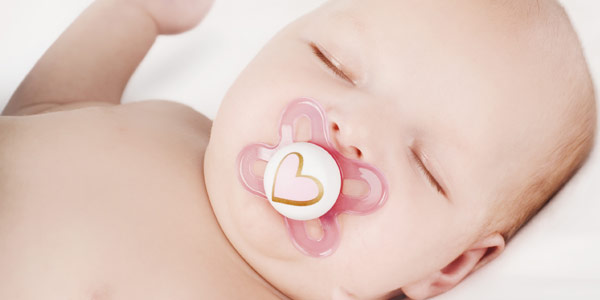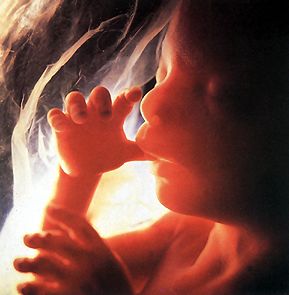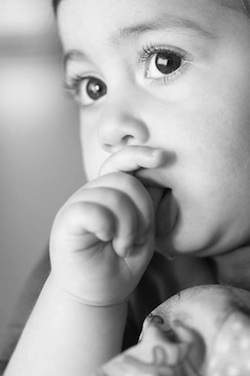Pacifiers (also known as “soothers”) are one of the heated debate topics amongst various health professionals (pediatricians, family doctors, dentists and lactation specialists, to name a few) as well as parents. There is a lot of information available on pacifiers, but unfortunately there is no “gold standard”. This blog post represents my personal view on pacifiers and I have based this view on as much evidence as I could research. At the very least, it will provide you with additional food for thought. For me, the use of a pacifier is a parental decision and not one to be made by a health professional.

Why use a pacifier?
Babies have an urge to suck; some even start in the womb. I remember that the ultrasound technician printed out a picture of our firstborn sucking his thumb. Sucking is soothing to a baby and can help them settle. A pacifier could provide that. When a baby cries in between feeds, it sometimes is an indication that they just want to suck on something.
 Pacifier vs. thumb/fingers
Pacifier vs. thumb/fingers
I often get asked this question: Is a pacifier better or worse than thumbs/fingers? There are pros and cons to both.
A pacifier can help prevent future problems with development of teeth. However, if the child still uses the pacifier when he/she has teeth, the use of a pacifier can increase the chances of cavities. This is particularly the case if a parent puts the soother in their mouth to “clean” it and then gives it back to the child. A parent with a history of cavities has a higher number of so-called “cavity-inducing bacteria” in their mouth, thereby increasing the chance of the child developing cavities. There have also been studies that show a pacifier can be protective against sudden infant death syndrome (SIDS), also known as crib death.
It’s ok if a child ends up being a thumb/finger sucker. There is no risk of introducing foreign bacteria, since it is their own. They always have their fingers with them, so there’s no panic among parents if they lose a pacifier in the car or while away from home. The downside comes when it’s time to stop. When it comes to stopping, it is easy to throw away a pacifier, less so with a thumb or finger.
If we choose to use a pacifier, when should we introduce this?
This is one of the main questions that can lead to serious debates amongst health professionals. There are those who believe the use of a pacifier negatively impacts breastfeeding and they will argue against the use of a pacifier for the duration of the breastfeeding period.
The American Academy of Pediatrics reommendation is to use it after the first month of life so enough time has passed for proper breastfeeding to be established.
I follow the advice of the Canadian Pediatric Society which does not state a specific timeline, but rather states that one can start when breastfeeding has been fully established (for some this could be as early as day 7 or 8). If infants are bottlefed and have shown to be able to drink from the bottle effectively, they could be given a pacifier as well, if parents so choose.
Pacifiers and teeth
Both the Canadian Dental Association and American Dental Association prefer pacifiers over finger-sucking, as the pacifier can be taken away. Prolonged usage and the use of sweetened pacifiers (dipped in sugar or honey) are big risk-factors for developing cavities. Do NOT dip the pacifier in sugar or honey.
Pacifiers and ear infections
The use of pacifiers and the incidence of ear infections are both highest in the first two years of life. Therefore, it is hard to do a study without finding that babies with ear infections also use pacifiers. This does not mean there is a direct relation. In a study looking at which micro-organism were found on pacifiers, the bacteria that is the cause of most bacterial ear infections (strep A) was NOT found. However, prolonged use of the pacifier (more than 5 hours per day) was found to be a contributing factor.
Most studies agree that pacifiers could be a potential risk factor for ear infections, but not the sole cause of them.
 When to stop using a pacifier
When to stop using a pacifier
Studies with regards to dental problems like cavities, overbites, etc. have shown that kids who used pacifier until one year of age had less problems with dental arch and occlusion compared to those who were still using a pacifier at age 2 and 3 years. Another study looked at children between 2 and 5 years and found that the longer the usage of the pacifier, the higher the incidence of overbite and cross bite.
There are also strong data to suggest that using a pacifier during the day (not related to sleep) in children older than 9 months has a negative impact on speech development.
Ideally, I would prefer to have the children off their pacifier by 12 months of age, and certainly not past age 2 years.
How to stop using a pacifier
“Out of sight, out of mind” is the best method, in my opinion. I don’t wean them off of the pacifier, I suggest to simply take it away one day (and preferably throw it in the garbage, so one cannot be tempted to give it back).
I love using the Soother Fairy for this: together with your child, collect all the soothers you have in the house, and put them in a garbage bag. Make a big deal out of this day, tell your child they are a big boy/big girl now and that the Soother Fairy will come to collect all the soothers, so she can give it to the babies that need them. Put the garbage bag out by your front door that night. The following morning will be a little present from the Soother Fairy. Hopefully your child feels like a big kid and you have thrown out the garbage bag, so you cannot be tempted to give a soother again.
Bottomline
1. The use of a pacifier is a parental decision, not that of a health professional.
2. Never dip a pacifier in sugar or honey.
3. Prolonged use of a pacifier is not recommended (both for delay of speech, as well as dental risks).
4. Try to have your child off the pacifier by age 1 yr ideally, and at the latest before the age of 2 yrs.
5. Try using the Soother Fairy method to get rid off the pacifier.

WONDERFUL ARTICLE!! Very helpful- We are going to try the “soother fairy” tommorow! thanks Dr.Sharon- hope all is well.
Sheila